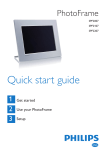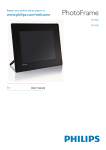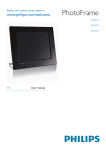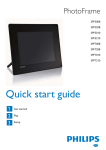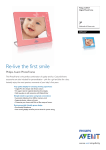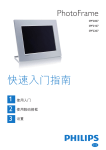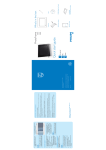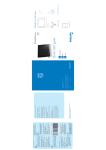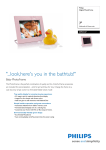Download Philips SPF2007
Transcript
Register your product and get support at PhotoFrame SFP2007 SPF2107 SPF2207 EN User manual 1 Important 2 Safety 2 Safety precautions and maintenance 2 Notice 2 Declaration of Conformity 2 End of life disposal 2 Recycling Information for Customers 3 Compliance with Electro-Magnetic Field (EMF) 3 Recycling 3 North Europe Information (Nordic Countries) 4 Banned Substance Declaration 4 2 Your Digital PhotoFrame Introduction What’s in the box Overview of your PhotoFrame 3 Get started Install the stand Connect power Connect a storage device Connect PC Turn on the PhotoFrame 4 Use your Digital PhotoFrame 5 5 5 7 8 8 8 8 9 9 5 Slideshow 18 Select slideshow sequence Select a transition effect Select slideshow frequency Display collage photos Select photo background 18 18 19 19 20 6 Setup 21 Select on-screen language Adjust display brightness Protect/Unprotect content of memory card Set time and date Set time and date format Show clock Set an event reminder Create an event reminder Set event time and date Set on/off a reminder Delete a reminder Select a reminder photo Set snooze Set display auto on/off by time Set on Demo Set auto orientation Set button sound View status of the PhotoFrame Set to factory default 21 21 22 22 23 24 24 25 25 26 27 27 28 29 30 31 31 32 32 10 Display photos 10 Browse photos in thumbnail mode and access photo menu 11 Select a photo effect 12 Select a photo frame 12 Rotate a photo 12 Zoom and crop a photo 12 Create an album 13 Delete an album 13 Rename an album 14 Play video 14 Play music 15 Play background music 16 Copy/Delete photos or files 16 7 Product information 33 8 Frequently asked questions 35 9 Glossary 36 Need help? Please visit www.philips.com/welcome where you can access a full set of supporting materials such as user manual, the latest software updates and answers to frequently asked questions. EN 1 E n g lish Contents 1 Important Safety Any operation expressly prohibited in this manual, any adjustments, or assembly procedures not recommended or authorised in this manual shall void the warranty. Safety precautions and maintenance • • • • • • • • • • Never touch, push, rub or strike the screen with hard objects as this may damage the screen permanently. When the product is not used for long periods, unplug it. Before you clean the screen, turn off and unplug the power cord. Only clean the screen with a soft, water-damp cloth. Never use substances such as alcohol, chemicals or household cleaners to clean the product. Never place the product near naked flames or other heat sources, including direct sunlight. Never expose the product to rain or water. Never place liquid containers, such as vases, near the product. Never drop the product. When you drop the product, it will be damaged. Keep the stand away from cables. Ensure that you install and use services or software only from trustworthy sources free of virus or harmful software. This product is designed for indoor use only. Only use the supplied power adaptor for the product. Notice Warranty No components are user serviceable. Do not open or remove covers to the inside of the product. Repairs may only be done by Philips Service Centres and official repair shops. Failure to do so shall void any warranty, stated or implied. 2 EN The making of unauthorized copies of copyprotected material, including computer programs, files, broadcasts and sound recordings, may be an infringement of copyrights and constitute a criminal offence. This equipment should not be used for such purposes. Declaration of Conformity Philips Consumer Lifestyle declares under our responsibility that the product is in conformity with the following standards EN60950-1:2006 (Safety requirement of Information Technology Equipment) EN55022:2006 (Radio Disturbance requirement of Information Technology Equipment) EN55024:1998 (Immunity requirement of Information Technology Equipment) EN61000-3-2:2006 (Limits for Harmonic Current Emission) EN61000-3-3:1995 (Limitation of Voltage Fluctuation and Flicker) following provisions of directives applicable 73/23/EEC (Low Voltage Directive) 2004/108/EC (EMC Directive) 2006/95/EC (Amendment of EMC and Low Voltage Directive) and is produced by a manufacturing organization on ISO9000 level. End of life disposal • Your new product contains materials that can be recycled and reused. Specialized companies can recycle your product to increase the amount of reusable materials and to minimize the amount to be disposed of. Please find out about the local regulations on how to dispose of your old monitor from your local Philips dealer. • (For customers in Canada and U.S.A.) Dispose of in accordance to local-state and federal regulations. For additional information on recycling contact www.eia.org (Consumer Education Initiative). Recycling Information for Customers Philips establishes technically and economically viable objectives to optimize the environmental performance of the organization’s product, service and activities. From the planning, design and production stages, Philips emphasizes the importance of making products that can easily be recycled. At Philips, end-of-life management primarily entails participation in national take-back initiatives and recycling programs whenever possible, preferably in cooperation with competitors. There is currently a system of recycling up and running in the European countries, such as The Netherlands, Belgium, Norway, Sweden and Denmark. In U.S.A., Philips Consumer Lifestyle North America has contributed funds for the Electronic Industries Alliance (EIA) Electronics Recycling Project and state recycling initiatives for end-of-life electronics products from household sources. In addition, the Northeast Recycling Council (NERC) - a multi-state non-profit organization focused on promoting recycling market development - plans to implement a recycling program. In Asia Pacific, Taiwan, the products can be taken back by Environment Protection Administration (EPA) to follow the IT product recycling management process, detail can be found in web site www.epa.gov.tw. Compliance with Electro-Magnetic Field (EMF) general have the ability to emit and receive electromagnetic signals. One of Philips’ leading Business Principles is to take all necessary health and safety measures for our products, to comply with all applicable legal requirements and to stay well within the EMF standards applicable at the time of producing the products. Philips is committed to develop, produce and market products that cause no adverse health effects. Philips confirms that if its products are handled properly for their intended use, they are safe to use according to scientific evidence available today. Philips plays an active role in the development of international EMF and safety standards, enabling Philips to anticipate further developments in standardisation for early integration in its products. E n g lish • Recycling Your product is designed and manufactured with high quality materials and components, which can be recycled and reused. When you see the crossed-out wheel bin symbol attached to a product, it means the product is covered by the European Directive 2002/96/EC: Never dispose of your product with other household waste. Please inform yourself about the local rules on the separate collection of electrical and electronic products. The correct disposal of your old product helps prevent potentially negative consequences on the environment and human health. Koninklijke Philips Electronics N.V. manufactures and sells many products targeted at consumers, which, like any electronic apparatus, in EN 3 North Europe Information (Nordic Countries) VARNING: FÖRSÄKRA DIG OM ATT HUVUDBRYTARE OCH UTTAG ÄR LÄTÅTKOMLIGA, NÄR DU STÄLLER DIN UTRUSTNING PÅPLATS. Placering/Ventilation ADVARSEL: SØRG VED PLACERINGEN FOR, AT NETLEDNINGENS STIK OG STIKKONTAKT ER NEMT TILGÆNGELIGE. Paikka/Ilmankierto VAROITUS: SIJOITA LAITE SITEN, ETTÄ VERKKOJOHTO VOIDAAN TARVITTAESSA HELPOSTI IRROTTAA PISTORASIASTA. Plassering/Ventilasjon ADVARSEL: NÅR DETTE UTSTYRET PLASSERES, MÅ DU PASSE PÅ AT KONTAKTENE FOR STØMTILFØRSEL ER LETTE Å NÅ. Banned Substance Declaration This product complies with RoHs and Philips BSD (AR17-G04-5010-010) requirements. 4 EN E n g lish 2 Your Digital PhotoFrame Congratulations on your purchase, and welcome to Philips! To fully benefit from the support that Philips offers, register your product at www.philips.com/welcome. Introduction • AC-DC power adaptor • CD-ROM • Digital User Manual • PC software for Windows • USB cable With the PhotoFrame, you can play: • JPEG photo • MP3 music • M-JPEG video (*.avi format) You can place the PhotoFrame on the table or hang it on the wall. What’s in the box • Philips Digital PhotoFrame PhotoFrame Quick start guide 1 2 3 Get started Play Setup Eng • • Stand Quick Start Guide EN 5 • (For SPF2107 and SPF2207) Two extra baby frames 6 EN E n g lish Overview of your PhotoFrame n a b d c e f g h i j k h a • Turn on/off the PhotoFrame c Kensington lock • Play slideshow/music/video Change mode for slideshow (For photo/video) Zoom in / / / • Select the previous/next/right/left item d OK • (For music/video) Pause or resume play • Confirm a selection m i b • • • l Slot for a USB cable to PC j CF • Slot for a CF card k SD/MMC/xD/MS/MS Pro • Slot for an SD/MMC/xD/MS/MS Pro card l DC • Socket for the AC-DC power adaptor m Stand hole n Wall mounting hole e • • Enter the main menu (For photo/video) Zoom out f RESET • Reset settings to factory default g • Slot for a USB flash drive EN 7 3 Get started Connect power Note Caution • When you position the PhotoFrame, ensure that the power plug and outlet are easily accessible. • Use the controls only as stated in this user manual. Always follow the instructions in this chapter in sequence. If you contact Philips, you will be asked for the model and serial number of this apparatus. The model number and serial number are on the back of the apparatus. Write the numbers here: Model No. __________________________ Serial No. ___________________________ 1 Connect the power cord to the DC socket of the PhotoFrame. b a Install the stand To place the PhotoFrame on a flat surface, you need install the supplied stand at the back of the PhotoFrame. 1 2 Connect the power cord to a power supply socket. Insert the stand into the PhotoFrame. Connect a storage device Caution • Do not remove a storage device from the PhotoFrame when files are transferring from or to the storage device. 2 Screw the stand into the stand hole firmly. 8 EN You can play photos, music or video in one of the following storage device which is connected to the PhotoFrame: • Compact Flash type I • Secure Digital (SD) • Secure Digital (SDHC) • Multimedia Card • Multimedia+ Card • xD card • Memory Stick • Memory Stick Pro (with adaptor) • USB memory drive 1 Insert a storage device firmly. » You can drag and drop files from the PC to the folder on the PhotoFrame. 2 E n g lish However, we do not guarantee the operations for all types of memory card media. After all copy and save actions are complete, disconnect the USB cable from the PC and the PhotoFrame. Turn on the PhotoFrame Note • You can only turn off the PhotoFrame after all copy and save actions are complete. » Photos in the storage device are displayed in slideshow mode. • To remove a storage device, pull it out from the PhotoFrame. 1 Press and hold for more than 1 second. » Help message for control keys is displayed. Connect PC Caution • Do not disconnect the PhotoFrame from the PC when files are transferring between the PhotoFrame and the PC. 1 Connect the supplied USB cable to the PhotoFrame and to the PC. • To access the main menu directly, press . EN 9 4 Use your Digital PhotoFrame Display photos Note • You can play only JPEG photos on the PhotoFrame. 1 » Photos in the album are displayed in thumbnail mode. 4 Press to start slideshow play. • In slideshow mode, press / to display the next/previous photo. • In slideshow mode, press to toggle between slideshow, browse, calendar, and Kiddy Clock (for SFP2107 and SPF2207) mode. Two options for Kiddy Clock (SPF2107): • Princess In the main menu, select [Photos] and then press OK to confirm. • » Available photo sources are displayed. 2 Select a photo source, and then press OK to confirm. 3 Select an album, and then press OK to confirm. 10 EN Astronaut Browse photos in thumbnail mode and access photo menu E n g lish Two options for Kiddy Clock (SPF2207): • Butterfly You can browse multiple photos in thumbnail mode. In thumbnail mode, you can access the photo menu to edit photos. • • • • In the main menu, select [Photos] and then press OK to confirm. • In Slideshow or Browse mode, you can press OK to browse photos in thumbnail mode. 2 Select a photo source, and then press OK to confirm. 3 Select an album, and then press OK to confirm. » Photos in the album are displayed in thumbnail mode. 4 Press / / / to select a photo, and then press OK to confirm. • To select all photos displayed on the screen, press and hold OK for more than 1 second. Rabbit Tip • 1 In slideshow mode, the PhotoFrame displays all photos automatically. In browse mode, the PhotoFrame displays the current photo and you can press / to display the next/ previous photo. In calendar mode, the PhotoFrame displays photos with the calendar. In Kiddie Clock mode, you can select a charming animation to match the frames of the PhotoFrame. EN 11 5 Press to access [Photo Menu] and manage the photo. Select a photo frame 1 In [Photo Menu], select [Frames] and then press OK to confirm. 2 Select a frame, and then press OK to confirm. Tip • If the number of photos in the album is over 16, you can press / to move to the next/previous 16 photos. Rotate a photo Select a photo effect 1 In [Photo Menu], select [Photo Effects] and then press OK to confirm. 2 Select an effect, and then press OK to confirm. 1 In [Photo Menu], select [Rotate] and then press OK to confirm. 2 Select an orientation, and then press OK to confirm. Zoom and crop a photo 1 12 EN In [Photo Menu], select [Zoom and Crop] and then press OK to confirm. Press to zoom in a photo. • Press to zoom out a photo. 3 Press / / / to crop the photo, and then press OK to confirm. 4 Select [Yes], and then press OK to confirm. 3 Select [New Album], and then press OK to confirm. » A keypad is displayed. 4 To enter the new name (up to 24 characters), select an alphabet/number and then press OK to confirm. • To switch between uppercase and lowercase, select [abc] on the displayed keypad and then press OK to confirm. 5 When the name is complete, select [Enter] and then press OK to confirm. E n g lish 2 Tip • Zoom and crop function is only applied to photos over 800 x 600 pixel. Create an album You can create an album on the PhotoFrame and on a storage device connected to the PhotoFrame. 1 In the main menu, select [Photos] and then press OK to confirm. 2 Select a photo source, and then press OK to confirm. Delete an album 1 2 3 Select an album. Press to access the album menu. Select [Delete Album], and then press OK to confirm. EN 13 » A confirmation message is displayed. Play video Note • You can play only M-JPEG video files (in *.avi format) on the PhotoFrame. • For best compatibility, you can use bundled PC software (for Windows) to transfer video files to your PhotoFrame and play. 4 1 In the main menu, select [Video] and then press OK to confirm. 2 Select a source, and then press OK to confirm. 3 Select an album/folder, and then press OK to confirm. • To select files in a sub-folder, repeat step 3. Select [Yes], and then press OK to confirm. Rename an album 1 2 3 4 Select an album. Press to access the album menu. Select [Rename Album], and then press OK to confirm. » A keypad is displayed. To enter the new name (up to 24 characters), select an alphabet/number and then press OK to confirm. • To switch between uppercase and lowercase, select [abc] on the displayed keypad and then press OK to confirm. 5 When the name is complete, select [Enter] and then press OK to confirm. 14 EN Select a file to play. • To select all files, press and hold OK. 5 Press to start play. During play, To stop, press and hold . To pause, press OK. To resume, press OK again. To play in full screen, press . To stop play in full screen, press . To adjust volume, press / . To select the next/previous file, press / . To mute play, press and hold until the icon is displayed. To change repeat mode, press repeatedly. • • • • • • • • • Play music Note • You can play only MP3 (MPEG Audio Layer III) music files on the PhotoFrame. 1 In the main menu, select [Music] and then press OK to confirm. 2 Select a source, and then press OK to confirm. 3 Select an album/folder, and then press OK to confirm. • To select files in a sub-folder, repeat step 3. 4 Select a file to play. • To select all files, press and hold OK. 5 Press to start play. During play, To pause, press OK. To resume, press OK again. To stop, press . To select the next/previous file, press / . To adjust volume, press / . To mute play, press and hold until the icon is displayed. To change repeat mode, press repeatedly. • • • • • • • EN E n g lish 4 15 Play background music 1 In the main menu, select [Music] and then press OK to confirm. 2 Select a source, and then press OK to confirm. 7 Select [Yes], and then press OK to start play. Copy/Delete photos or files You can copy or delete a photo or a music/ video file on the PhotoFrame. Caution • Never remove a storage device before the copy or delete action completes. Before you copy or delete a file, 3 Select an album/folder, and then press OK to confirm. • To select files in a sub-folder, repeat step 3. 4 Select a file, and then press OK to confirm. • To select all files, press and hold OK. 5 6 Press 16 In the main menu, select [Photos] / [Video] / [Music] and then press OK to confirm. 2 Select a source, and then press OK to confirm. 3 Select an album/folder, and then press OK to confirm. • To select a sub-folder, repeat Step 3. 4 Select a photo/file, and then press OK to confirm. • To select all photos/files in the ablum/ folder, press and hold OK. 5 Press to access the menu list. Select [Play at Background], and then press OK to confirm. EN 1 to access the menu list. 1 In the menu list, select [Copy to], and then press OK to confirm. 2 Select a target folder, and then press OK to start copy. E n g lish To copy, Tip • When there is not enough memory to store more images, an error message is displayed. To delete, 1 In the menu list, select [Delete] and then press OK to confirm. EN 17 5 Slideshow Select a transition effect 1 In the main menu, select [Slideshow] and then press OK to confirm. 2 Select [Transition Effect], and then press OK to confirm. 3 Select a transition effect, and then press OK to confirm. Select slideshow sequence You can display the slideshow in sequence or randomly. 1 2 In the main menu, select [Slideshow] and then press OK to confirm. Select [Slideshow sequence], and then press OK to confirm. Tip • If you select [Random], all available transition effects 3 Select an option, and then press OK to confirm. 18 EN randomly apply to all slideshow photos. Display collage photos 1 In the main menu, select [Slideshow] and then press OK to confirm. 1 In the main menu, select [Slideshow] and then press OK to confirm. 2 Select [Frequency], and then press OK to confirm. 2 Select [Collage], and then press OK to confirm. 3 Select a transition time, and then press OK to confirm. 3 Select [Multi], and then press OK to confirm. 4 5 6 Select a layout. 7 Press (Right) to select [Photo 1]. Press (Right) again to access the photo source options. Select a photo from a photo source. EN 19 E n g lish Select slideshow frequency 8 Repeat steps 5 to 7 until all photos are selected for the format. » If you select [Auto fit], the PhotoFrame extends a photo to fill the screen with picture distortion. 9 Press to start collage display. • To stop collage display, select [Slideshow] > [Collage] > [Single] and then press OK to confirm. Tip • • If you select a collage layout, the PhotoFrame displays a static collage and the slideshow mode is deactivated. If you select [Random] format, the PhotoFrame automatically does the random collage base on the optimal layout of photos and displays the collages in slideshow mode. Select photo background You can select a background border color for photos that are smaller than the screen of the PhotoFrame. 1 In the main menu, select [Slideshow] and then press OK to confirm. 2 Select [Background Color], and then press OK to confirm. 3 Select a background color / [Auto fit] / [RadiantColor], and then press OK to confirm. » If you select a background color, the PhotoFrame displays a photo with a background color or black bar. 20 EN » If you select [RadiantColor], the PhotoFrame extends the color on the edges of a photo that is smaller than the full screen to fill the screen without black bars or aspect ratio distortion. Select on-screen language 1 2 Adjust display brightness You can set the brightness of the PhotoFrame to achieve the best view. 1 In the main menu, select [Setup] and then press OK to confirm. In the main menu, select [Setup] and then press OK to confirm. 2 Select [Brightness], and then press OK to confirm. Select [Language], and then press OK to confirm. 3 Press / to adjust brightness, and then press OK to confirm. 3 Select [Language Setting], and then press OK to confirm. 4 Select a language, and then press OK to confirm. EN 21 E n g lish 6 Setup Protect/Unprotect content of memory card Set time and date 1 In the main menu, select [Setup] and then press OK to confirm. 2 Select [Time and Date], and then press OK to confirm. 3 Select [Set time] / [Set date], and then press OK to confirm. You can enable the delete function on a storage device available on the PhotoFrame. To avoid deleting photos on a storage device, you can also disable the delete function on a storage device. 1 In the main menu, select [Setup] and then press OK to confirm. 2 Select [Memory Card], and then pres OK to confirm. 3 22 Select [Delete enable] / [Delete disable], and then press OK to confirm. EN Press / / / and OK to enter the current time/date, and then press OK to confirm. 2 Select [Time and Date], and then press OK to confirm. 3 Select [Set time format] / [Set date format], and then press OK to confirm. 4 Select the time/date format, and then press OK to confirm. E n g lish 4 Set time and date format You can set the format of the time and date displayed on the PhotoFrame. 1 In the main menu, select [Setup] and then press OK to confirm. EN 23 Show clock 3 Select [Show clock], and then press OK to confirm. 4 Select an option, and then press OK to confirm. • [No clock] (No clock is displayed.) • [In slideshow] (Clock is displayed.) • [Both] (Both clock and calendar are displayed.) You can show clock or calendar in slideshow on the PhotoFrame. 1 2 In the main menu, select [Setup] and then press OK to confirm. Select [Time and Date], and then press OK to confirm. Set an event reminder You can create a reminder for a special event, and you can also select a photo to be displayed at a selected time. Tip • Ensure that you set the current time and date of the PhotoFrame before you set an event reminder. 24 EN 1 In the main menu, select [Setup] and press OK to confirm. 4 To enter the new name (up to 24 characters), select an alphabet/number and then press OK to confirm. • To switch between uppercase and lowercase, select [abc] on the displayed keypad and then press OK to confirm. 5 When the name is complete, select [Enter] and then press OK to confirm. Set event time and date Note • Ensure that you set the current time and date of the 2 PhotoFrame before you set time and date for an event reminder. Select [Event Reminder], and then press OK to confirm. 1 3 In the main menu, select [Setup] and then press OK to confirm. Select [New reminder], and then press OK to confirm. EN 25 E n g lish » A keypad is displayed. Create an event reminder 2 3 Select [Event Reminder], and then press OK to confirm. Select a reminder, and then press OK to confirm. 4 Select [Set time] / [Set date], and then press OK to confirm. 5 Press / / / and OK to set the time/ date, and then press OK to confirm. Tip • When the reminder alerts, you can press any button once to stop the reminder. To stop the snooze function, press the same button twice. 26 EN Set on/off a reminder 1 In the main menu, select [Setup] and then press OK to confirm. 2 Select [Event Reminder], and then press OK to confirm. Select a reminder, and then press OK to confirm. 5 Select [Yes], and then press OK to confirm. E n g lish 3 Select a reminder photo You can select a photo to display for a reminder. Each event reminder activates the latest defined photo only. If there is no defined photo, the reminder takes the default Philips start up photo. 4 1 In the main menu, select [Setup] and then press OK to confirm. 2 Select [Event Reminder], and then press OK to confirm. Select [Set], and then press OK to confirmn. • Select [On] to set the reminder on, and then press OK to confirm. • To set the reminder off, select [Off] and then press OK to confirm. Delete a reminder 1 In the main menu, select [Setup] and then press OK to confirm. 2 Select [Event Reminder], and then press OK to confirm. 3 Select a reminder, and then press OK to confirm. 4 Select [Delete reminder], and then press OK to confirm. EN 27 3 4 Select a reminder, and then press OK to confirm. Select [Photo], and then press OK to confirm. 5 Select a photo source, and then press OK to confirm. 6 Select a photo, and then press OK to confirm. 28 EN Set snooze 1 In the main menu, select [Setup] and then press OK to confirm. 2 Select [Event Reminder], and then press OK to confirm. Select [Snooze], and then press OK to confirm. 2 Select [Smart power], and then press OK to confirm. 4 Select an options, and then press OK to confirm. 3 Select [Set time], and then press OK to confirm. 4 Select [Weekday] / [Weekend], and then press OK to confirm. Set display auto on/off by time You can configure the time for the PhotoFrame to turn on or off the display automatically. Note • Ensure that you set the current time and date of the PhotoFrame before you set the auto on/off function. 1 In the main menu, select [Setup] and then press OK to confirm. EN 29 E n g lish 3 5 6 Select [Auto on] / [Auto off], and then press OK to confirm. • To cancel [Auto on] / [Auto off], select [Set On/Off] > [Off]. Set on Demo 1 In the main menu, select [Setup] and then press OK to confirm. 2 Select [DEMO], and then press OK to confirm. 3 Select [On], and then press OK to confirm. Press / / / and OK to set the time for auto-on/auto-off function, and then press OK to confirm. Tip • • 30 Weekday: Monday 00:00 to Friday 23:59 Weekend: Saturday 00:00 to Sunday 23:59 EN Set button sound You can display photos in the correct orientation depending the horizontal/vertical orientation of the PhotoFrame. 1 In the main menu, select [Setup] and then press OK to confirm. 2 Select [Set Beep], and then press OK to confirm. 3 Select [On] to turn on the button sound, and then press OK to confirm. • To turn off the button sound, select [Off] and then press OK to confirm. 1 2 3 In the main menu, select [Setup] and then press OK to confirm. Select[Auto Orientation], and then press OK to confirm. Select [Enable] to set on auto orientation function, and then press OK to confirm. • To set off auto orientation function, select [Disable] and then press OK to confirm. EN 31 E n g lish Set auto orientation View status of the PhotoFrame Set to factory default 1 In the main menu, select [Setup] and then press OK to confirm. 2 Select [Settings], and then press OK to confirm. 3 Select [Default], and then press OK to confirm. You can find the free space, connected media, and the firmware version of the PhotoFrame. 1 2 In the main menu, select [Setup] and then press OK to confirm. Select [Status]. » The status of the PhotoFrame is displayed on the right of the screen. 32 EN Note • Product information is subject to change without prior notice. Picture/Display • Viewing angle: @ C/R > 10, 140° (H)/100° (V) • Lifetime, to 50% brightness: 20000 hr • Aspect ratio: 4:3 • Panel resolution: 800 x 600 • Brightness (typical): 250 cd/m² • Contrast ratio (typical): 300:1 Audio feature • Audio supported format: MP3 (MPEG Audio Layer III) • Bit rate: 16 ~ 320 Kbps • Sample rate: 8 ~ 48 KHz • Speaker output power (RMS): 0.8 W Video feature • Video supported format: *.avi (M-JPEG) • Video size: 640 x 480 • Frame rate: 30 fps Connectivity USB: USB 2.0 Host, USB 2.0 Slave Storage media • Memory card types: • Compact Flash type I • Secure Digital (SD) • Secure Digital (SDHC) • Multimedia Card • xD card • Memory Stick • Memory Stick Pro (with adaptor) • USB: USB flash drive • Built-in memory capacity: 512 MB (For up to 500 High Definition photos, around 26MB used by system) Dimensions • Set dimensions with stand (W x H x D): 194.0 x 158.8 x 93.0 mm • • Weight (Main unit): 0.385 kg Temperature range (operation): 0°C 40°C/32°F - 104°F • Temperature range (storage): -10°C 60°C/14°F - 140°F Power • Input: 100 - 240 V ~ 50/60 Hz 0.3 A • Output: 9 V 1.0 A • Efficiency level: IV • Consumption: System on 7 W • Power mode supported: AC powered Accessories • AC-DC Adaptor • USB cable • Stand • (For SPF2107 and SPF2207) Two extra baby frames • Quick start guide • CD-ROM, including • User Manual • PC software for Windows Convenience • Card Reader: Built-in • Photo format supported: JPEG photo (Up to 10MB JPEG files, Up to 48 Megapixels) • Placement supported: Photo auto orientation, Landscape, Portrait • Buttons and controls: 3 buttons, 4-way navigation key and enter • Playback mode: Full screen browse, Slideshow, Thumbnail browse • Album management: Create, Delete, Edit, Rename • Photo edit: Copy, Delete, Rotate, Zoom & crop • Photo effects: Black and White, Sepia • Slideshow setting: Random, Sequential, Transition effect, Collage (multiple pictures) • Screen background: Black, White, Gray, Auto fit, Radiant color • Setup function: Brightness adjustment, Language, Status, Event reminder with snooze, Beep on/off, Set time and date, Clock display enable/disable, Photo source, Auto on/off • System status: Firmware version, Remaining memory EN 33 E n g lish 7 Product information • • • • 34 Plug & Play Compatibility: Windows Vista, Windows 2000/XP or later Regulatory Approvals: BSMI, C-Tick, CCC, CE, GOST, PSB, Switzerland Other convenience: Kensington lock compatible On-Screen Display languages: English, Spanish, German, French, Italian, Dutch, Danish, Russian, Simplified Chinese, Traditional Chinese, Portuguese EN Is the LCD screen touch-enabled? The LCD screen is not touch-enabled. Use the buttons on the back to control the PhotoFrame. Can I switch different slideshow photos by using different memory cards? Yes. When a memory card is connected to the PhotoFrame, you can play photos on the specific memory card in slideshow mode. Will the LCD be damaged, if I keep showing the same photo for a long time? No. The PhotoFrame can display the same photo continuously for 72 hours without any damage to the LCD screen. Can I use the PhotoFrame during its display auto-off periods? Yes. You can press to wake up the PhotoFrame. Why does my PhotoFrame not show some of my photos? The PhotoFrame supports only JPEG photos. Ensure that these JPEG photos are not damaged. Why does my PhotoFrame not show some of my music files? The PhotoFrame only supports MP3 (MPEG Audio Layer III) music files. Ensure that these MP3 (MPEG Audio Layer III) music files are not damaged. Why does my PhotoFrame not show some of my video files? The PhotoFrame only supports M-JPEG video files (in *.avi format). Ensure that these M-JPEG (motion JPEG) video files are not damaged. Why does the PhotoFrame not go into autooff status after I set it? Ensure that you set the current time, autooff time, and auto-on time correctly. The PhotoFrame automatically turns off its display exactly at the auto-off time. If the time has already passed for the day, it starts to enter auto-off status at the specified time from the next day. Does the PhotoFrame support CF II? No. The PhotoFrame does not support CF II. Can I increase the memory size to store more pictures on the PhotoFrame? No. The internal memory of the PhotoFrame is fixed and cannot be expanded. However, you could switch between different photos by using different storage devices on the PhotoFrame. The PhotoFrame is ON but the PhotoFrame does not respond anymore. What can I do? Ensure that the PhotoFrame is turned on. Then, use a pin to trigger the RESET button located on the back to restore the system. EN 35 E n g lish 8 Frequently asked questions 9 Glossary A Aspect ratio Aspect ratio refers to the length to height ratio of TV screens. The ratio of a standard TV is 4:3, while the ratio of a high-definition or wide TV is 16:9. The letter box allows you to enjoy a picture with a wider perspective on a standard 4:3 screen. C CF Card CompactFlash card. A memory card that uses flash memory to store data on a small card. A CompactFlash card makes data easy to add to a wide variety of computing devices, including digital cameras and music players, desktop computers, personal digital assistants (PDAs), digital audio recorders, and photo printers. J JPEG A very common digital still picture format. A still-picture data compression system proposed by the Joint Photographic Expert Group, which features small decrease in image quality in spite of its high compression ratio. Files are recognized by their file extension ‘.jpg’ or ‘.jpeg.’ Memory Stick Memory Stick. A flash memory card for digital storage on cameras, camcorders and other handheld devices. MMC Card MultiMedia Card. A flash memory card that provides storage for cellphones, PDAs and other handheld devices. The card uses flash memory for read/write applications or ROM chips (ROM-MMC) for static information, the latter widely used for adding applications to a Palm PDA. Motion JPEG Motion JPEG (M-JPEG) is an informal name for multimedia formats where each video frame or interlaced field of a digital video sequence is separately compressed as a JPEG image. It is often used in mobile appliances such as digital cameras. S SD Card Secure Digital Memory Card. A flash memory card that provides storage for digital cameras, cellphones and PDAs. SD Cards use the same 32 x 24mm form factor as the MultiMediaCard (MMC), but are slightly thicker (2.1mm vs. 1.4mm), and SD Card readers accept both formats. Cards up to 4GB are available. X K Kensington lock A Kensington Security Slot (also called a K-Slot or Kensington lock). Part of an anti-theft system. It is a small, metal-reinforced hole found on almost all small or portable computer and electronics equipment, particularly on expensive and/or relatively light ones, such as laptops, computer monitors, desktop computers, gaming consoles, and video projectors. It is used for attaching a lock-and-cable apparatus, in particular those from Kensington. 36 M EN xD Card EXtreme Digital Picture Card. A flash memory card used in digital cameras. © 2009 Koninklijke Philips Electronics N.V. All rights reserved. UM_V1.7 12NC






































